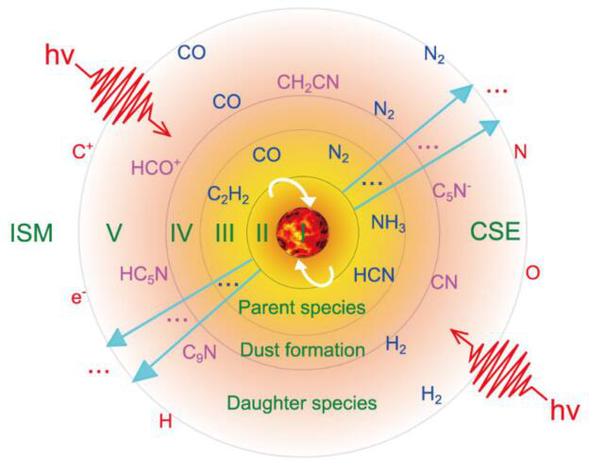
Recently, a research article about the formation mechanism of the silicon-bearing molecules such as the c-SiC3 molecules in the AGB star IRC+10216 has been published in the Proceedings of the National Academy of Sciences of the United States of the America (abbreviated as PNAS). It is a joint study associated with the experiments of reaction dynamics involving atomic and molecular beams, the high-level ab initio calculations and the astrochemical modeling, indicating the trait of strong alliance in this newly-emerging interdisciplinary field — astrochemistry. This work was accomplished by Dr. Tao Yang from State Key Laboratory of Precision Spectroscopy in the East China Normal University, Dr. Xiaohu Li from the Astrochemical Group of Xinjiang Astronomical Observatory, CAS, and the scientists from University of California at Berkeley and University of Hawaii at Manoa of the United States of America.
AGB stars are the stars at their late stages. Known as the “molecular factory” in the Universe, they sputter gas phase molecules as well as dusts outwards in the form of the stellar winds, leading to the formation of dense and hot circumstellar envelopes, one famous object of which is the carbon-rich IRC+10216. Up to 200 interstellar molecules have been identified so far, and more than half of them were discovered in the circumstellar envelope of IRC+10216 that is closest to the Earth. Therefore, substantial attentions about the studies of circumstellar molecules of AGB stars have been attracted from the experimental physicists, theoretical chemists, and astrochemists.

Illustration of molecular distribution in the circumstellar envelope of IRC+10216
The experimentalists prepared three atomic/molecular beams: Si (3P), Si (1D) and SiH (X2Π), which were first characterized via the laser-induced fluorescence detection in order to determine the generation of their quantum states. It was soon discovered that Si (3P) can react with CH2CCH2 or CH3CCH molecules under the crossed-beam collision energy of 30 kJ mol-1, while Si(3P) and SiH (X2Π) are able to react with them respectively under different reaction dynamics. By controlling the reaction systems in the gas phase, we studied the reaction energies, the reaction barriers, the molecular structures of certain intermediate states and products, which resulted into the finding that the H2 decomposing channel contributes significantly in the reaction of Si(1D) with CH2CCH2 or CH3CCH. High level electronic structure calculations revealed the structures for the reactants, intermediates, and products via geometry optimizations and frequency calculations using the ωB97X-V density functional and the cc-pVTZ basis set. Transition state structures were calculated using the freezing string method to generate an initial structure and Hessian which were then refined by a transition state search using the partitioned-rational function optimization eigenvector following method and followed by a frequency calculation. These calculations were also carried out at the ωB97X-V/cc-pVTZ level of theory. As a result, we identified the leading reaction channels including H2C=C=C=Si and c-SiCH=C=CH, as well as the photodissociation channel to c-SiC3(X1A1) under the influence of Lyman-α photons in the calculations. In the astrochemical modeling, we applied the experimental and theoretical results into the chemical reaction network of the circumstellar envelope of the AGB star, and delivered the delicate results about the distribution, formation and destruction mechanisms, fractional abundances and the column densities of c-SiC3, SiC4, SiC3H2, CH3CCH and their isomers, thus providing vital support in the astronomical observation in the future.
During the most recent years, the radio astronomy have advanced rapidly and telescopes of high sensitivity and resolution are being built and operated successfully, which greatly promotes the development of astrochemistry. These telescopes of high performance include but are not limited to Herschel space telescope from European Space Agency, Atacama Large Millimeter/submillimeter Array from Chile, Five-hundred-meter Aperture Spherical Telescope from Guizhou province of China, Shanghai 65m Radio Telescope (Tianma), STeerable 110-m Aperture Radio Telescope (or QiTai radio Telescope, QTT) from Xinjiang Observatory of China, and the Square Kilometre Array project in which China is one of the chief members. Nowadays, the field of astrochemistry in China and the world is facing a booming 'golden age', and the interdisciplinary interaction of astrochemical modelling, physical chemistry experiments and computations as well as the astronomical observation is gradually becoming an inevitable trend.
This work is supported the by the Fundamental Research Funds for the Central Universities, the Special Funding for Advanced Users, budgeted and administrated by Center for Astronomical Mega-Science, Chinese Academy of Sciences, and the National Natural Science Foundation of China.